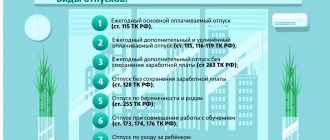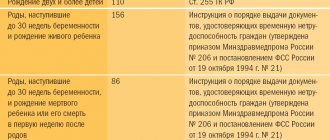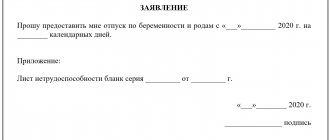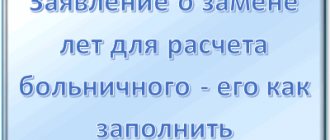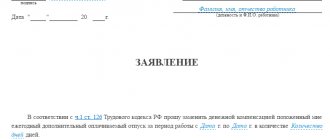In recent years, increased attention has been paid to demography in our country, because its future power and prosperity directly depend on the birth rate and population growth. Concern for additional provision for women, the time given for development, gestation and nursing of the born child will have an impact on its further health and development.
Extension of sick leave for pregnancy and childbirth by 16 days
About sick leave for pregnancy and childbirth
In 2021, additions and changes were made to the legislation of the Russian Federation to increase and expand assistance to families with children. Articles 255 and 266 of the Labor Code of the Russian Federation provide for the provision of maternity leave to women.
It is the responsibility of each manager to provide a woman who is about to give birth to a child with leave within the time limits required by law.
Child care time is divided into periods:
- maternity leave;
- additional leave for complicated childbirth;
- care leave until the child reaches 1.5 years of age;
- parental leave until the child reaches 3 years of age.
Note ! These holidays are paid on the basis of separate regulatory documents.
If a woman works while carrying a child, she is granted maternity leave - 70 days. The date is set by the decision of the gynecologist of the Women's Consultation on the expected date of birth of the child at 30 weeks of pregnancy. At birth without postpartum complications, a woman is entitled to another 70 days to restore her health and care for her baby. But childbirth is a difficult, difficult procedure for mother and child, which often involves medical complications and injuries. In such cases, the woman will have 16 days added to her maternity leave, making it 86 days in total.
Article 10 of Federal Law No. 255
If a happy mother’s doctors, using an ultrasound, have determined that two or more fetuses have been conceived, then maternity leave is extended to 84 (70+14) days, and at their birth by 110 (70+40) days.
Note ! Unfortunately, there are many cases where pregnancy and childbirth occur with deviations and are difficult for mothers and children to tolerate. They often end in a major operation or caesarean section, which can cause additional harm to the woman and prolong her recovery period.
A sick leave certificate issued by a medical institution is the basis for payments for all days due for pregnancy and postpartum leave, including additional days for complications. The amount of payments depends on the average salary calculated from the income received over the last two years.
Attention:
- sick pay for pregnancy and childbirth should not be lower than the minimum wage at the time of accrual.
- in accordance with Art. 217 of the Tax Code of the Russian Federation, sick leave and other payments for children are not subject to taxes and fees.
Excerpt from Article 217 of the Tax Code of the Russian Federation
If a woman voluntarily works until the birth of the child, without serving the required leave after the birth of the child, this is not prohibited by law and only the actual time spent on sick leave is paid.
Note ! During pregnancy, a woman must be released from hard work and transferred to light work with mandatory retention of earnings calculated on average.
For the entire period of maternity leave and time to care for a child, the employee retains his job. Every month the employee is paid a child benefit established by the state. The first 1.5 years of child care are included in the continuous insurance period of the Pension Fund.
The first 1.5 years of child care are included in the insurance period
All women giving birth have the right, in the event of any complications, to additional maternity leave - this is provided for by law, and few managers will decide to violate them.
Note ! Women's rights are protected and protected by the state.
Is it possible to extend?
Maternity leave increases if the birth was difficult or two or more children were born, which for some reason was not known in advance. In this case, we are talking about extending the standard maternity leave, which lasts 140 days and is 70 days before the birth of the child and 70 days after.
In order to extend your vacation, you will have to write a separate application and indicate the reason, which is confirmed by a certificate of incapacity for work.
During pregnancy
The prenatal period in all situations lasts 70 days. It can be extended only in case of multiple pregnancy, if it is detected before birth. In this case, the leave before childbirth is 84 days. Such leave is issued earlier.
After childbirth
There are several reasons for increasing the duration of an employee's leave during the postpartum period after childbirth:
- Childbirth occurring with complications (surgery, cesarean section) – extension for 16 days.
- Premature birth – also an increase of 16 days.
- Multiple babies are born, and multiple births are known before birth - plus 40 days after the baby is born.
- Several babies are born, but multiple births are unknown in advance - 54 days are added after birth.
All reasons must be documented. Another sick leave is issued, and on its basis the employer is obliged to extend the leave under labor law.
What is included in the concept of complicated childbirth and how are they interpreted by doctors and legislation?
The Ministry of Health of the Russian Federation, in instruction No. 01-97, determined the procedure for how and by whom the issue of providing additional leave in connection with postpartum complications is decided. It lists possible complications after which the mother in labor needs additional days to recover her health.
All issues related to the provision of additional leave are assigned to the commission of the Maternity Hospital (medical institution), consisting of the chief physician, the attending physician and a specialized physician according to the type of complication.
Note ! The commission examines how the birth took place and how complications affected the postpartum condition of the mother and child.
Excerpt from the instruction of the Ministry of Health of the Russian Federation No. 01-97
What does the list of postpartum complications include?
Childbirth is always painful, and it is a difficult ordeal for a woman and her baby. Much depends on physical health, the absence of chronic diseases, as well as the readiness of the mother in labor to give birth to a child. Experienced gynecologists and obstetricians help a woman during childbirth, take all measures to prevent complications, but sometimes they are simply objective. Additional sick leave for pregnancy and childbirth (BIR) for 16 days is given for recovery after major operations and postpartum pathologies.
Postpartum complications can be divided into:
- pathological childbirth;
- prenatal abnormalities;
- birth injuries and pathologies;
- postpartum illnesses and complications;
- multiple pregnancy.
There are several types of postpartum complications
Pathological birth
What is considered a pathological birth:
- Complicated childbirth entails the need for planned and sometimes emergency surgery to remove the baby. This operation is called a “caesarean section”. The woman will need additional time to recover from deep anesthesia, to protect herself while the internal and external sutures fuse.
- Before giving birth, there may be a need for another surgical intervention, episiotomy, cutting the walls of the vagina to facilitate the birth of the child naturally. The patient needs additional time for the incisions to heal and heal.
- Surgical methods also include manual separation of the placenta in cases of its fusion with the walls of the uterus. This is a painful procedure and is difficult for women in labor to endure.
Multiple pregnancy
When a woman is pregnant with two, in rare cases three or even more babies, the birth takes place in a tense environment for the woman in labor and for the obstetrician. In such cases, caesarean section is often used. Babies are born with low weight, weakened, and require additional care and attention. Mom needs recovery after a difficult birth. The BIR leave for such cases increases and amounts to 84 (70 + 14) before childbirth and 110 (70 +40) after the birth of children. If during the nursing process twins were not identified by doctors, prenatal leave does not increase and is 70 days.
In case of multiple pregnancy, mothers must increase their BIR leave.
Prenatal abnormalities
What is considered to be prenatal abnormalities:
- Early discharge of amniotic fluid without contractions for a long time indicates a rupture of the membrane, which threatens the loss of the child, so an emergency cesarean section is performed.
- The baby may be born prematurely - a week or several months in advance - premature with low weight. The future health and life of the child depends only on medical care, medical personnel and the care of the mother.
- Post-term pregnancy lasting more than 42 weeks. If stimulation does not produce results, surgery is performed.
- Another dangerous pathology is the absence of intense contractions or a slow pregnancy. This condition cannot last for a long time and without surgery it will end tragically for the baby.
- In case of irregularities in the heartbeat or breathing problems, urgent measures are taken for surgical intervention. Otherwise, the child in the womb simply does not have enough strength to be born naturally.
- The incorrect position of the fetus in the womb will prevent it from being born on its own, and if it is not possible to turn the baby, a caesarean section is performed to save the mother and child.
If there are prenatal abnormalities, the BIR leave is increased by 16 days
Birth injuries and pathologies
Postpartum complications that affect the further well-being of the mother and newborn child require special consideration.
- When the fetus has difficulties along the way of birth with obstruction of the shoulders, it gets stuck, the obstetrician takes measures to intervene and extract with assistive means, which can subsequently affect the health of the born child.
- During a stormy, rapid birth, the placenta can prematurely exfoliate, causing prolapse of the umbilical cord - this threatens a large loss of blood in the woman in labor and hypoxia of the child. With such a pathology, obstetricians resort to emergency surgery.
- If a child swallows amniotic fluid at birth, an embolism occurs - it can cause serious consequences. Resuscitation and long-term treatment will be required.
- Lack of oxygen can cause fetal hypoxia. They are taking all measures to ensure a quick delivery; a prolonged lack of oxygen threatens the baby with irreversible consequences.
Birth injuries are also a reason to extend BIR leave
Postpartum illnesses and complications
For mothers, childbirth is also a very difficult test, which can result in the acquisition of various diseases.
- Difficult-to-stop uterine bleeding may occur. If it continues for more than 15 days, the discharge is foul-smelling, this is a signal that you should immediately contact a gynecologist so as not to trigger the condition.
- Inflammation of the uterus and endometritis are difficult for women to tolerate. Their temperature rises, the inflammatory process of internal organs begins, which will require long-term treatment.
- During pregnancy, inflammation of the amniotic membranes may occur, which is accompanied by a sharp increase in body temperature, purulent discharge from the uterus, and ichor. Urgent delivery is required.
- Breastfeeding mothers often experience postpartum mastitis, which can be caused by dangerous bacteria and microbes. With severe inflammation of the mammary gland, a woman may lose milk.
- After a cesarean section, there is a threat of inflammation of the entire abdominal cavity, which can lead to peritonitis; all organs become infected with toxins, leading to disruption of their functions.
- Infectious kidney damage, pyelonephritis, after childbirth often occurs when microbes and bacteria enter the bladder through the genital tract. Causes sharp pain and fever.
If the mother suffered in any way during childbirth, her sick leave must be extended
Required documents to receive child care benefits
An application for parental leave must be accompanied by the following materials confirming the joyful event:
- A copy of the birth certificate or certificate of guardianship. If leave is not allocated to parents, then materials certifying the relationship are attached. When an heir appears abroad, certificates are issued at the consulate or local authorities. The foreign certificate must be translated into Russian.
- A certificate from the work of the other half of the couple stating that such leave was not received . It can be issued on the institution’s letterhead. If the leave is taken by a member of the family where the child was born, both parents provide the certificates. If the second parent works in several companies, then certificates are provided from each company.
- Certificate of earnings for the last two years (form 182n), subject to insurance contributions . This form is provided by persons who have recently started a job and there is no information about their earnings. It is needed to calculate the amount of the monthly benefit.
- Request to change the calculation period for calculating benefits . This request is submitted by an employee if her baby has already been born recently. This change applies if the benefit amount is received for more than the last two years.
About providing sick leave
During maternity leave (BIR), a woman can be issued sick leave twice:
- for the standard, prescribed period - 140 days;
- for complications during childbirth, extended for a period of 16 days or 40 days for the birth of two or more children.
Note ! BIR leave is provided to working women, students, military personnel and those registered with the employment and employment service. Unemployed people are not entitled to leave under the BIR.
Paid leave under the BIR cannot be received by unemployed women or those who are not registered with the Labor Protection Center.
The registration of a sick leave certificate according to the BIR is carried out in the antenatal clinic, where a pregnant woman initially applies, regardless of the stage of pregnancy. She takes tests and registers. The gynecologist issues a sick leave certificate for BIR for 140 days after determining the gestational age of 30 weeks.
A sick leave certificate is drawn up on a standard form at the antenatal clinic, which indicates:
- Full name of the pregnant woman;
- the full name of the institution of her place of work where the sick leave will be sent;
- code of the reason for issuing a sheet with the start date of the vacation according to the BIR and the end date;
- signature and seal.
Sick leave according to BIR
For timely payment, it must be given without delay to the employer with an application attached.
There is no developed standard form for applying for leave under the BIR, but it must include the following data:
- name of the institution or enterprise where the woman works;
- Full name of the head of this organization;
- Full name and position of the applicant;
- request for leave under the BIR for compulsory social insurance.
The date and signature of the applicant are affixed at the bottom.
Example of an application for leave under the BIR
Note ! If the birth of a child occurred with at least one of the complications described above, then, in accordance with Article 255 of the Labor Code of the Russian Federation, the mother in labor at the medical institution where the birth took place is given a deadline for extending sick leave.
Additional sick leave is issued to extend disability leave resulting from complications in childbirth or the birth of two or more children.
An additional sick leave certificate is issued when the woman in labor provides the following documents:
- a photocopy of the passport with its original attached;
- a photocopy of the first sick leave certificate issued at the antenatal clinic;
- an exchange card issued at the antenatal clinic, in which the head physician makes a note about the completion of the birth and indicates the cause of the complication.
- a copy of the child's birth certificate.
An additional sick leave is issued on the standard form of a medical institution, which must indicate:
- Full name of the woman in labor;
- the full name of the institution of her place of work where the sheet will be sent;
- code of the reason for renewal;
- extension period with expiration date;
- signature and seal.
A woman is provided with additional sick leave if it is necessary to extend sick leave according to the BIR
A sick leave certificate according to the BIR is submitted to the organization with an application attached in person or through an authorized representative. You can send them by registered or certified mail, but it will take much longer. If a woman resigns of her own free will during a BIR leave or in connection with the liquidation of an organization, additional sick leave is paid by the Social Insurance Fund.
The rules for calculating payment for main and additional leave under the BIR are the same - it all depends on the average salary for the two previous years. Payments are calculated based on the dates indicated on each sick leave.
Note ! In this case, the date of birth of the child does not matter, even if he was born before or after the calculated date in the antenatal clinic.
The amount of payments depends on the average salary of a woman
List of documents
To extend maternity leave, you will need some documentation:
- application for extension indicating the reason why additional days are needed;
- identification document;
- sick leave confirming a multiple or complicated pregnancy or early birth;
- child's birth certificate - for parental leave.
Documents can be brought in person or sent by mail. A third party is also allowed to do this, but then his passport and power of attorney to represent the interests of this employee are added to the list.
Changes in legislation
In 2021, the Russian Federation introduced significant changes in payments to women who gave birth to one or more children.
The list of financial assistance payments and their amount has been significantly changed and expanded. Payments are provided on the following grounds to support the family during the pregnancy and birth of a child:
- payment for medical registration at the antenatal clinic for up to 12 weeks;
- one-time payment upon the birth of one or more children;
- payment for maternity leave and complicated childbirth;
- payments at the birth of the first child monthly until one and a half years;
- monthly care payments from 1.5 to 3 years for each child;
- maternity capital at the birth of the second and/or subsequent children.
Articles 6, 9 Federal Law No. 81
Attention ! Guardians and adoptive parents have the same rights to payments and maternity leave.
How is a vacation transfer processed?
It matters who the initiative comes from.
At the employee's initiative
An application to postpone vacation at the employee’s initiative is written, sample. In mandatory cases, as well as when the employer does not object, a transfer order .
For example, if an employee, in violation of the requirements of Art. 136. TC was not paid vacation pay on time (not transferred or not credited to the account), he makes a request.
Sample application for transfer of leave at the initiative of the employee:
- addressed to the head of the organization;
- contains the name and position of the applicant;
- in the main part, the employee sets out the essence of the appeal , for example, like this: “Due to the fact that I was not paid vacation pay on time, I ask you to postpone the start date of the vacation from t-to t-t”;
- contains signature and date .
An application for transferring vacation (a sample can be downloaded above) may look like this :
- Name of company.
- Date and order number.
- In the content part: “Due to the fact that employee t-date was not paid vacation pay on time, I order: to postpone the vacation to t-date; make changes to the vacation schedule; familiarize the applicant’s order with the employee t-something.”
- The order determines the persons responsible for its execution: for example, the head of the OK, secretary, deputy manager, etc.
- The basis for the order may be indicated - a statement from the employee on t-date.
- Number and signature of the manager and employees familiar with the order.
Find out when it is possible to postpone vacation at the request of the employee and the reasons for the refusal by management in the article at the link.
Application for postponing vacation according to the vacation schedule due to production needs.
Application to postpone leave for family reasons, sample.
At the initiative of the employer
For the “exceptional” case provided for in Art. 124. there is no clear order. The law only requires the employee's consent , which must be obtained before issuing an order to postpone the vacation to the next year. Depending on this, the vacation will either take place or be postponed.
An order to postpone an employee’s vacation at the initiative of the employer.
In practice, these relationships can be formalized either by a memo from an authorized person (for example, the head of a department) addressed to the head of the organization , outlining the exceptional need to postpone the vacation of the employee.
On this note, the employee makes, for example, the following entry: “I do not object to the postponement of my vacation scheduled on the t-date for the next 2017.”
Or a separate application for the transfer of leave is drawn up in the form of an independent document, in which the employee, turning to the manager, declares his consent to the transfer.
After this, an order is issued.
Payments
Payment of maternity leave for basic and additional sick leave depends on the average monthly salary for the last two years for working women.
- If it exceeds the current minimum wage, 100% is paid.
- If it is below the minimum wage, then it is paid from 05/01/2018 in the amount of 11,163 rubles.
- For full-time students and registered unemployed women, the minimum wage is 11,163 rubles.
- For women registered at the antenatal clinic before 12 weeks of pregnancy, an incentive payment of 628.47 rubles is paid (613 rubles in 2021). It is accrued along with the main payments under the BIR.
- The amount of one-time payment for each child has been increased to 16,759.09 rubles.
Payment for maternity leave depends on the average monthly salary of a woman
In 2021, the minimum and maximum amounts of payments have been determined, which are paid at the place of work with the provision of a copy of the child’s birth certificate issued by the registry office.
| Pay | Minimum | Maximum |
| For 140 days of leave under BIR for the birth of one child | 51119 rub. | 301000 rub. |
| For 156 days of leave under BIR for complicated and difficult births | 57852 rub. | RUB 305,507.64 |
| For 194 days of leave under BIR for the birth of 2 or more children | 71994.9 rub. | RUB 417,233.86 |
| 70 days for adoption or guardianship of one child under 3 months of age | Average monthly salary in rubles. | Average monthly salary in rubles. |
| 110 days for adoption or guardianship of 2 or more children under 3 months of age | Average monthly salary in rubles. | Average monthly salary in rubles. |
The monthly benefit for a child under 1.5 years old is 40% of the average salary for the last two years. If the average family income is small, then the woman is entitled to payment according to the minimum wage at the birth of her first child.
The monthly minimum allowance for the birth of one child is 4512 rubles, for two - 6554.9 rubles.
Maternity capital is accrued at the birth of the second and/or subsequent children, and in 2021 it amounts to 453.026 thousand rubles. It can be spent:
- to improve living conditions,
- for children's education,
- for support and treatment if the child has been disabled since childhood,
- for mother's pension in future old age.
- for the construction of a house.
Maternity capital can be used for specific purposes determined by law
How to extend up to 3 years without going to work?
As soon as the period under the BiR ends, a woman can immediately fill out an application for child care for up to 1.5 years. During this time, the woman receives state benefits (40% of her salary). You can immediately write an application for a vacation of up to 3 years without interrupting your previous vacation.
If a woman immediately wrote an application only for the first part of the vacation, after the child reaches 1.5 years old, it may be necessary to extend the vacation. There are not always places in kindergarten, and not all children adapt to it.
Thus, maternity leave can be extended in two cases:
- after the period of pregnancy and childbirth - for child care leave for up to 1.5 or 3 years;
- after parental leave for up to 1.5 years - for parental leave for up to 3 years.
To extend maternity leave, you need to perform the following algorithm of actions:
- To write an application.
- Copy the child's birth document.
- Submit the application and certificate to personnel officers in person or by mail.
- Personnel employees must draw up an order.
- The director approves the order.
- The applicant also signs the order.
- HR department employees are required to enter data into the section of the employee’s personal card.
To receive benefits for up to 1.5 years, you will also need a certificate from the child’s father (or from the mother, if the father is applying for benefits) that the other parent is not paid benefits at his job.
Rules, provision of documents and terms of payment of maternity and other payments
Receiving the required payments, with the exception of maternity benefits under the BIR, including for complicated childbirths, is possible not only for mothers, but for fathers or other close relatives who will care for the child. To do this, you need to collect a package of documents and submit it to management.
Within the statutory deadlines for payment of leave under the BIR, when all documents are provided to the organization, the administration is obliged to:
- issue an order for leave under the BIR, including additional leave for complicated childbirth;
- within 10 days, calculate all vacation pay according to the BIR, including payment for timely registration in the antenatal clinic;
- payment is made on the day the salary is received, but can be made on the next date of transfer of the total salary;
- the entire amount is accrued and paid, according to the submitted documents, at the same time.
The employer is obliged to make the required payments
To receive a calculation and receive benefits, a woman must collect a complete package of documents. It should include:
- a certificate completed by a gynecologist at the antenatal clinic confirming timely registration for pregnancy registration up to 12 weeks;
- sick leave for BIR and additional sick leave for complicated childbirth;
- application addressed to the manager;
- original and copy of the child's birth certificate. The manager has the right to verify its authenticity;
- a certificate from the place of work of the child’s father stating that he has not been paid child benefits;
- For those who are not working, but are registered with the employment and employment service of women at their place of residence, all payments are made by the Social Insurance Fund.
- Full-time students submit documents to the administration of the educational institution at their place of study.
If a pregnant woman is a full-time student, she must provide documentation to the administration of the educational institution
Advice ! Sick leave certificates must be carefully checked for correctness in medical institutions. Errors are not allowed in them.
Can the vacation period be extended for urgent TD?
Inviolable guarantees are provided to all pregnant women by Art. 261 TK. It states that a woman “in a position” cannot be fired, even if her employment contract is coming to an end. If, before the expiration date of the contract, the employee brought a certificate from the antenatal clinic, then her employer can only:
- Issue an order to extend the contract until the end of the pregnancy or until the expiration of the labor and employment leave (until the last day, taking into account all extensions).
- Request a monthly certificate from the woman about the gestational age.
- If a woman has safely reached 30 weeks and received sick leave, it is possible to terminate the fixed-term employment only after the end of the entire period of incapacity for work due to pregnancy and childbirth.
- If the pregnancy ends without a happy event, then the termination of the employment relationship is allowed to be formalized within a week from the date when the employer became aware or should have become aware of this event.
Benefit payment procedure
According to labor legislation, payment of child benefits is made on the same days when wages are paid at the enterprise.
Considering that, according to the law, salaries are issued at least twice - once in the form of an advance, and the second - in the form of wages, a maternity leaver can choose one of two options:
- receive benefits on the days the advance is issued;
- receive benefits on paydays for the month worked.
The law provides a woman with the opportunity to receive the entire benefit amount at once. However, to do this, you must submit an application before the child is two years old.
Remember! If an application for the full amount of benefits is submitted after the child reaches the age of two, the social insurance department at the place of residence will have to provide documents that justify the impossibility of filing an application earlier.
Despite the fact that the benefit is paid by the employer, the money is allocated by social insurance, so the employer, on its own initiative or at the request of the maternity leaver, does not have the right to pay benefits several months in advance.
If such a fact is established, social insurance has the right to stop paying compensation to the employer.
When applying to an employer for payment of benefits, a woman must indicate how she wants to receive money - by card, current bank account, postal transfer.
Having chosen a method that satisfies it, you should indicate all the necessary details. This can be stated both in the text of the statement itself and in the form of an annex to it.
